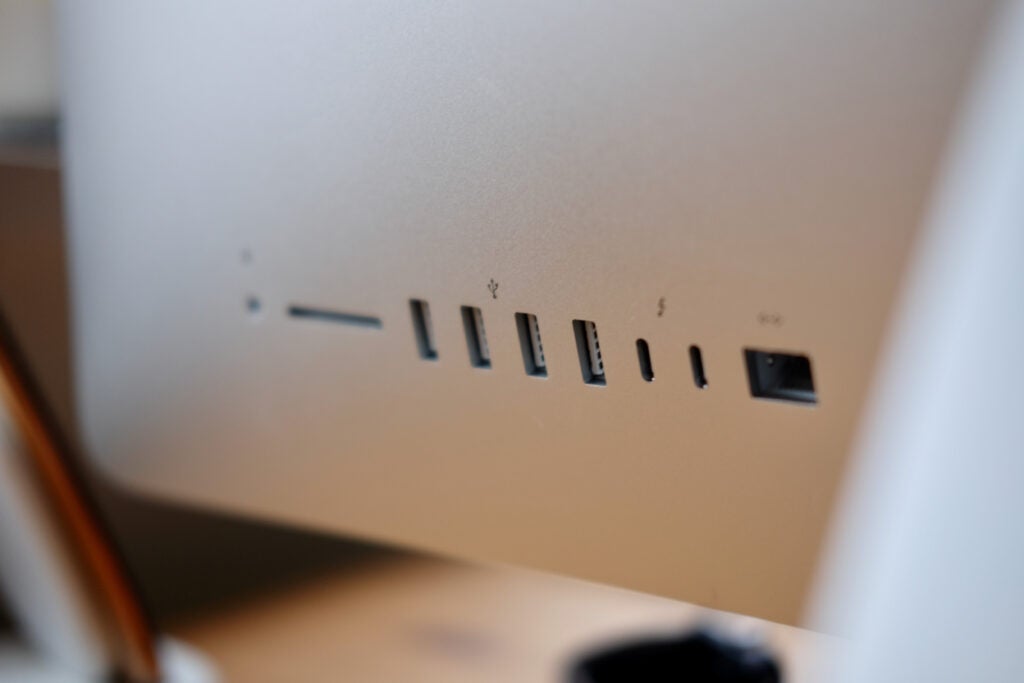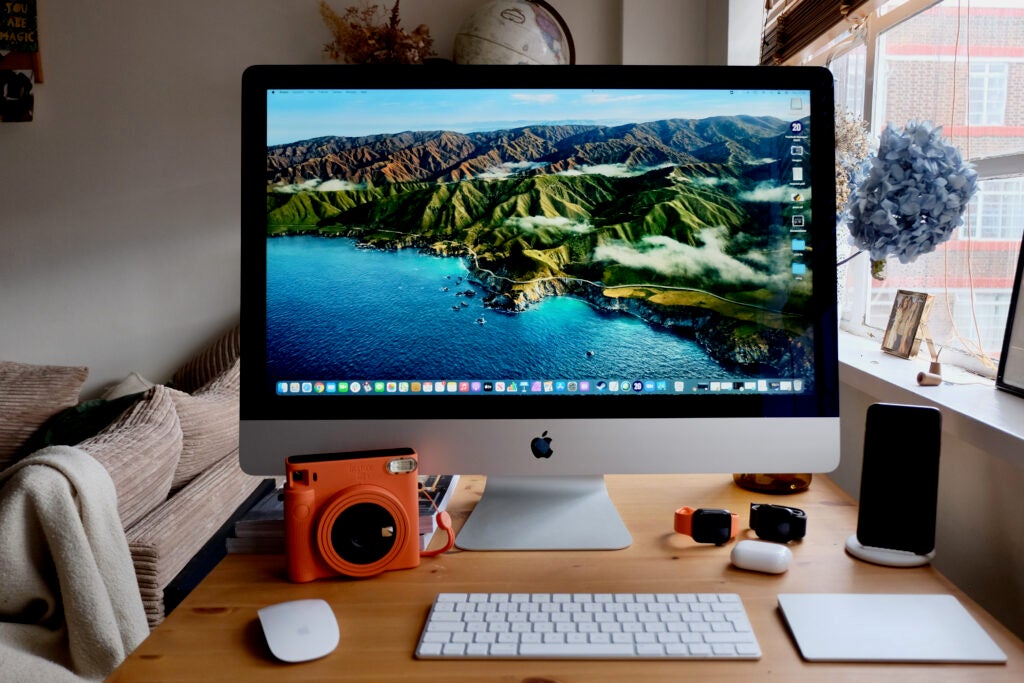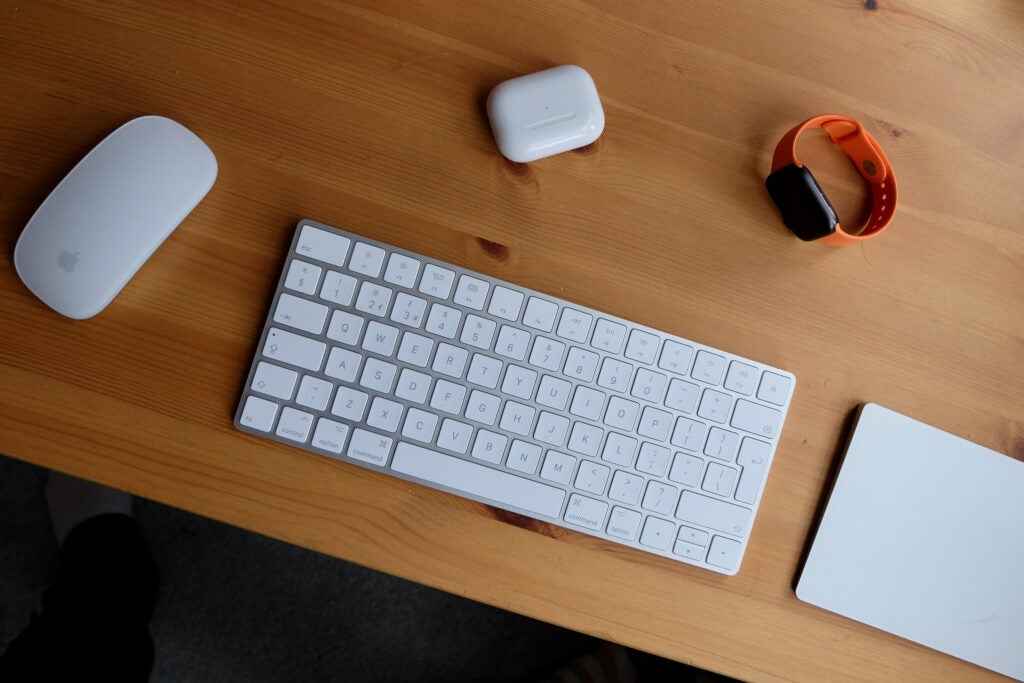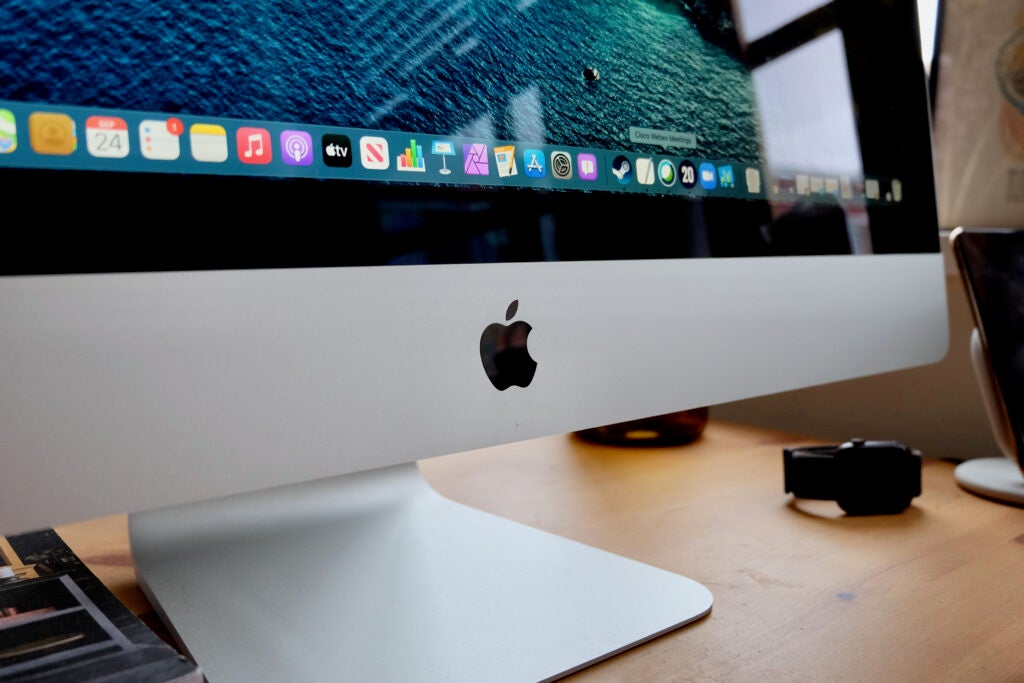Apple iMac 27-inch (2020)

The Apple iMac 2020 is a fantastic all-in-one desktop that’s ideal for working from home and for those who want something other than a laptop.
Before this latest refresh, rumours were swirling that Apple was about to redesign the iMac for the first time in nearly a decade. That didn’t turn out to be the case, with Apple possibly saving it for its upcoming Apple Silicon model instead. But the iMac 2020 shouldn’t be dismissed even if it’s not a complete revolution.
This is an excellent desktop that packs a truly stunning display, various customisation options and far more user-friendly feature than your typical laptop.
This review will cover the 27-inch version, which received the majority of the new updates. There is a 21.5-inch too, but that was mainly left untouched – aside from the addition of SSDs across the board.
Related: Best Desktop PC
Apple iMac 2020 Design – Could do with a new look, but remains a design icon
Apple has decided against redesigning the iMac this year, which might make some think twice about going for this model. With all the rumours of a completely new look, with far slimmer bezels and a more modern style proving untrue.
Apple has used this basic design for nearly a decade now, something you rarely see in tech these days. You might assume that’d make the iMac 2020 feel old, but like a classic car it has managed to stay relevant and I still think it looks good.

The sides are still super-thin, with a bulge out of the back for the internal components. There’s a sturdy aluminium base and a removable panel that gives you easy access to the four RAM slots if you want to add more. The port selection remains the same: an SDXC card slot, 3.5mm headphone port, four USB-A ports and two Thunderbolt 3 (UBS-C) ports. You’ve also got Gigabit ethernet, which can be upgraded to a 10Gb ethernet option for £100/$100.
This is a very flexible selection of ports and if you’re coming from a laptop/monitor setup then you’ll appreciate having everything you need within easy reach.
Of course, as with any design that’s been around for years there are certainly areas that could be improved. While I remain a big fan of the overall aesthetic, the chunky bezel surrounding the display needs to go.
Not only does this make the content feel a whole lot less immersive than it should, it means the overall machine is much larger than it should be for a 27-inch all-in-one computer. A slimmer bezel would allow for a more svelte machine, or it could let Apple cram an even larger panel into a similarly-sized housing.

I’ve also grown tired of the two included accessories you get with the iMac, neither of which neither are good enough. The Magic Keyboard is too small, lacks backlighting and doesn’t have a dedicated number pad. And then you’ve got the Magic Mouse 2, which retains the severely inconvenient charging point on the bottom.
You’re also missing any sort of biometric log-in, something that’s available on just about every other Apple device. A TouchID sensor included into the keyboard would make a whole lot of sense, as would some form of Face ID. The only way you can avoid inputting your password every time you wake the iMac up is to use an Apple Watch for authentication.
Apple iMac 2020 Screen – The biggest upgrade is a £500 optional extra
As with the design, the screen on the iMac 2020 is virtually identical to the one on the outgoing model. That’s perfectly fine by me, as this remains a truly excellent panel.
The screen itself is 27-inches, with a 5K resolution (5120 x 2880), use of the P3 colour gamut that has become common across Apple’s line and True Tone tech. It’s a supremely bright, colour accurate and sharp panel.
There is a new feature, but it’s more of an ‘added extra’. This is the ‘nano-textured glass’ option, which Apple has plucked right from the Pro Display XDR and it adds something akin to a matte finish without the loss of contrast a usual matte screen can have.
This is a £500/$500 extra and it doesn’t come as standard on any of the models, even if you go for the top-end SKU. The price sounds a lot and for the average consumer it is – however if you need a display that can be used in sunnier environments then it’ll likely be an easy decision to make. It’s also a lot cheaper than the same coating on the XDR Display, so at least Apple is bringing the price down.
My review unit came with the usual glossy panel, so I can’t attest to the quality of the nano-textured glass. What I can say is that if you work in a very bright room or close to a window, then it might just be worth the extra outlay.

Another highlight feature that Apple has now added to just about every Mac, iPad and iPhone is True Tone. While this was on the last-gen iMac, it will feel like a new upgrade for those who bought their current iMac before 2019.
True Tone adapts the colour temperature of the display to match your environment and it’s particularly noticeable on harsh white colours. If you’re reading a document for example, the white becomes a little more orangey and slightly easier on the eyes as a result. It’s not a huge difference, but you’ll appreciate if you’re stuck in front of this screen all day. My only slight issue is that it can be really obvious on this large screen when the colour temperature is changing, which can give a jarring feel.
It’s also important to note you’ll want to disable this completely if you’re doing work where colour accuracy is important.
Related: iPhone 12
Apple iMac 2020 Performance – A versatile machine that feels Pro
The iMac 2020 27-inch is a seriously versatile machine. There are multiple options available, ranging from a base 10th-gen Intel Core i5 processor with Radeon Pro 5300 graphics, to a top-end 10th-gen Intel Core i7 chip with Radeon Pro 5500 XT graphics. You can then customise further with Apple directly and pick a 10th-gen i9 if you fancy extra processing power.
RAM sits at 8GB across all the models, however this can be customised with up to 128GB 2666MHz DDR4 memory. 8GB of RAM feels a little stingy when you’re spending over two grand, however the modules are easily accessible and Apple leaves two slots free so you can easily double the 8GB to 16GB without much hassle. The SSD options range from 512GB to 8TB and there is no longer an option for the older Fusion Drives – it’s SSD across the board.
| iMac (2020) | 16-inch MacBook Pro (2019) | MacBook Air (2020) | |
| Geekbench 5 single core | 1369 | 1211 | 819 |
| Geekbench 5 Multi core | 7529 | 6631 | 1942 |
The options here are fantastic and really makes the iMac a machine that can be used by both consumers and pros. The base model is perfectly adequate for those who just want a fantastic and very fast desktop machine, while those who want to push up the RAM, processor and storage can do so.
The model I have in for testing is the off-the-shelf top-end model, with the i7 and 8GB RAM. It’s a fantastic workhorse and absolute joy to use. I’ve edited huge RAW files and exported 4K videos without any issues and the real star is just how quiet the machine stays.
In terms of benchmarking, this particular model scored 1369 in the single-core and 7529 in the multi-core test. For comparison, this means the iMac’s processing power is superior to both the 16-inch MacBook Pro and MacBook Air by a fair distance.
Now, there’s quite a big elephant in the room and that’s the upcoming switch away from Intel chips to Apple’s own Silicon. All we know at this stage is that it’s coming, and the first Apple Silicon machines will arrive this year. Rumours suggest the iMac is eventually inline for the move, but at this stage we don’t know what the benefits will be. I have to say while an Apple Silicon iMac has me excited, I am far more interested in the benefits it can bring to laptops and how things like battery life can be improved. Still, it may be worth holding off on a new iMac upgrade until 2021.

Other areas of performance are equally fantastic here. You’ve got excellent sounding speakers, a brand-new 1080p webcam that’s a huge step in the right direction and surprisingly good microphones too. I recorded a demo video and the quality compared to a MacBook Pro was night and day. You’ll still want a proper external microphone for professional work, but for everything else the setup here is good.
Apple has said that T2 chip inside the iMac helps the new 1080p camera improve exposure and enables face detection for FaceTime calls.
At launch, the iMac 2020 runs macOS Catalina, but over the coming months it’ll be upgraded to Big Sur. Big Sur brings not only support for Apple Silicon, but a big visual refresh that’s heavily inspired by iOS.
Icons have been changed, the Control Center from iOS has been added and the widgets have been redone.

Should you buy the Apple iMac 27-inch (2020)?
The iMac 2020 is a fantastic machine. It’s versatile, customisable and suitable for everyone from home workers looking for an all-in-one solution to professionals put off by the iMac Pro’s eyewatering price.
A new design, improved accessories and a cheaper ‘matte’ finish for the display are all glaring missed opportunities, but I can see those being addressed when Apple switches this to its new in-house chips. If you don’t want to wait for whatever comes next for the iMac line, then you won’t be disappointed by this iMac.
The post Apple iMac 27-inch (2020) appeared first on Trusted Reviews.
Source Trusted Reviews

No comments